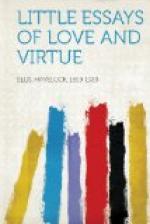Obviously, in this view of marriage, sexual activity was regarded as an exclusively masculine function, in the exercise of which women had merely a passive part to play. Any active participation on her side thus seemed unnecessary, and even unbefitting, finally, though only in comparatively modern times, disgusting and actually degrading. Thus Acton, who was regarded half a century ago as the chief English authority on sexual matters, declared that, “happily for society,” the supposition that women possess sexual feelings could be put aside as “a vile aspersion,” while another medical authority of the same period stated in regard to the most simple physical sign of healthy sexual emotion that it “only happens in lascivious women.” This final triumph of the masculine ideals and rule of life was, however, only achieved slowly. It was the culmination of an elaborate process of training. At the outset men had found it impossible to speak too strongly of the “wantonness” of women. This attitude was pronounced among the ancient Greeks and prominent in their dramatists. Christianity again, which ended by making women into the chief pillars of the Church, began by regarding them as the “Gate of Hell.” Again, later, when in the Middle Ages this masculine moral order approached the task of subjugating the barbarians of Northern Europe, men were horrified at the licentiousness of those northern women at whose coldness they are now shocked.
That, indeed, was, as Montaigne had seen, the central core of conflict in the rule of life imposed by men on woman. Men were perpetually striving, by ways the most methodical, the most subtle, the most far-reaching, to achieve a result in women, which, when achieved, men themselves viewed with dismay. They may be said to be moved in this sphere by two passions, the passion for virtue and the passion for vice. But it so happens that both these streams of passion have to be directed at the same fascinating object: Woman. No doubt nothing is more admirable than the skill with which women have acquired the duplicity necessary to play the two contradictory parts thus imposed upon them. But in that requirement the play of their natural reactions tended to become paralysed, and the delicate mechanism of their instincts often disturbed. They were forbidden, except in a few carefully etiquetted forms, the free play of courtship, without which they could not perform their part in the erotic life with full satisfaction either to themselves or their partners. They were reduced to an artificial simulation of coldness or of warmth, according to the particular stage of the dominating masculine ideal of woman which their partner chanced to have reached. But that is an attitude equally unsatisfactory to themselves and to their lovers, even when the latter have not sufficient insight to see through its unreality. It is an attitude so unnatural and artificial that it inevitably tends to produce a real coldness which




